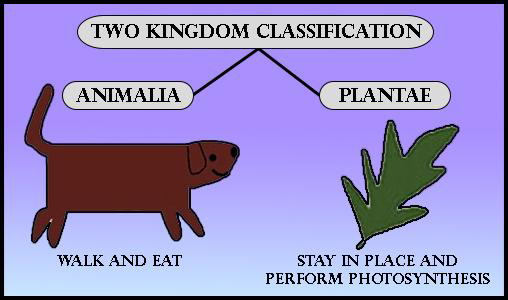
What is a two-kingdom classification? Give its drawbacks.
Answer
501.6k+ views
Hint: The kingdom discussed only the plants and animals along with their various characteristics and is a primitive system of classification that involves only the differentiation of groups based on their habitat.
Complete answer:
In the taxonomic hierarchy, kingdoms stand second in line. In 1793 Carl Linnaeus gave the term kingdom and introduced the nomenclature based on the rank system. The two-kingdom classification was introduced by Aristotle in his book ‘History of Animals ‘ while his student Theophrastus has written the book History of Plants, named Historia Plantarum. During ancient times, living beings were classified into two groups, plants, and animals.
Later, in 1735 Carolus Linnaeus first published the two kingdoms of living organisms. These kingdoms include the kingdom Plantae for plants and the kingdom Animalia for animals. The classification was based on the nutrition and locomotion of an individual. Linnaeus under the kingdom Animalia placed all the multicellular organisms along with the unicellular protozoans. The animal’s kingdom was based on holozoic nutrition, locomotion, and complex body structure. The plant’s kingdom was based on autotrophic nutrition, locomotion absent (immobile), and the body structure is simple and spread out which includes algae, fungi, plants, and bacteria.
Drawbacks
-It has placed the two different groups, the eukaryotes and the prokaryotes in the same kingdom.
-It has placed the unicellular and multicellular organisms in the same kingdom.
-It did not give any evidence regarding the evolutionary relationship between the plants and animals.
-The acellular organisms like viruses are not placed in any of the kingdoms.

Note: There were various other kingdoms that were produced, the two kingdom classification (Linnaeus), three kingdom classification Linnaeus introduced plants, animals, and vegetable kingdom), later three kingdom classification was proposed by Antoine van Leeuwenhoek which include plants, animals, and protists. The fourth kingdom classification (Herbert F. Copeland he described the kingdom Plantae, the kingdom Animalia, the kingdom Monera, and the kingdom Protista). The five-kingdom classification was introduced by R. H. Whittaker which includes the kingdom Monera, Protista, Fungi, Plantae, and Animalia.
Complete answer:
In the taxonomic hierarchy, kingdoms stand second in line. In 1793 Carl Linnaeus gave the term kingdom and introduced the nomenclature based on the rank system. The two-kingdom classification was introduced by Aristotle in his book ‘History of Animals ‘ while his student Theophrastus has written the book History of Plants, named Historia Plantarum. During ancient times, living beings were classified into two groups, plants, and animals.
Later, in 1735 Carolus Linnaeus first published the two kingdoms of living organisms. These kingdoms include the kingdom Plantae for plants and the kingdom Animalia for animals. The classification was based on the nutrition and locomotion of an individual. Linnaeus under the kingdom Animalia placed all the multicellular organisms along with the unicellular protozoans. The animal’s kingdom was based on holozoic nutrition, locomotion, and complex body structure. The plant’s kingdom was based on autotrophic nutrition, locomotion absent (immobile), and the body structure is simple and spread out which includes algae, fungi, plants, and bacteria.
Drawbacks
-It has placed the two different groups, the eukaryotes and the prokaryotes in the same kingdom.
-It has placed the unicellular and multicellular organisms in the same kingdom.
-It did not give any evidence regarding the evolutionary relationship between the plants and animals.
-The acellular organisms like viruses are not placed in any of the kingdoms.

Note: There were various other kingdoms that were produced, the two kingdom classification (Linnaeus), three kingdom classification Linnaeus introduced plants, animals, and vegetable kingdom), later three kingdom classification was proposed by Antoine van Leeuwenhoek which include plants, animals, and protists. The fourth kingdom classification (Herbert F. Copeland he described the kingdom Plantae, the kingdom Animalia, the kingdom Monera, and the kingdom Protista). The five-kingdom classification was introduced by R. H. Whittaker which includes the kingdom Monera, Protista, Fungi, Plantae, and Animalia.
Recently Updated Pages
Master Class 11 Economics: Engaging Questions & Answers for Success

Master Class 11 Business Studies: Engaging Questions & Answers for Success

Master Class 11 Accountancy: Engaging Questions & Answers for Success

Master Class 11 English: Engaging Questions & Answers for Success

Master Class 11 Computer Science: Engaging Questions & Answers for Success

Master Class 11 Maths: Engaging Questions & Answers for Success

Trending doubts
State and prove Bernoullis theorem class 11 physics CBSE

1 ton equals to A 100 kg B 1000 kg C 10 kg D 10000 class 11 physics CBSE

State the laws of reflection of light

One Metric ton is equal to kg A 10000 B 1000 C 100 class 11 physics CBSE

Difference Between Prokaryotic Cells and Eukaryotic Cells

1 Quintal is equal to a 110 kg b 10 kg c 100kg d 1000 class 11 physics CBSE




